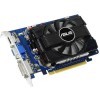- Qualcomm Launches Snapdragon 4 Gen 2 Mobile Platform
- AMD Launches Ryzen PRO 7000 Series Mobile & Desktop Platform
- Intel Launches Sleek Single-Slot Arc Pro A60 Workstation Graphics Card
- NVIDIA Announces Latest Ada Lovelace Additions: GeForce RTX 4060 Ti & RTX 4060
- Maxon Redshift With AMD Radeon GPU Rendering Support Now Available
ASUS GeForce 210, GT 220 & GT 240

This past fall, NVIDIA filled out the remainder of its GT200 series of graphics cards with three models. For basic computing, there’s the $40 GeForce 210, while for those looking to get a bit of light gaming done, there’s the $60 GT 220. And to round things off, there’s the $90 GT 240, which handles all of today’s games rather well at 1080p.
Page 5 – Crysis Warhead
Like Call of Duty, Crysis is another series that doesn’t need much of an introduction. Thanks to the fact that almost any comments section for a PC performance-related article asks, “Can it run Crysis?”, even those who don’t play computer games no doubt know what Crysis is. When Crytek first released Far Cry, it delivered an incredible game engine with huge capabilities, and Crysis simply took things to the next level.
Although the sequel, Warhead, has been available for just about a year, it still manages to push the highest-end systems to their breaking-point. It wasn’t until this past January that we finally found a graphics solution to handle the game at 2560×1600 at its Enthusiast level, but even that was without AA! Something tells me Crysis will be de facto for GPU benchmarking for the next while.
Manual Run-through: Whenever we have a new game in-hand for benchmarking, we make every attempt to explore each level of the game to find out which is the most brutal towards our hardware. Ironically, after spending hours exploring this game’s levels, we found the first level in the game, “Ambush”, to be the hardest on the GPU, so we stuck with it for our testing. Our run starts from the beginning of the level and stops shortly after we reach the first bridge.

I’m sure it will come as no surprise to anyone, but Crysis on a low-end graphics card is… brutal. Is that enough emphasis? On the GT 240, it was bearable, but on the others… well, during our run, people get blown up. I was wishing I was one of those people.


For the third time in a row, the GT 240 falls just behind the HD 5670. To be fair, AMD’s card is newer (released less than two weeks ago), but the GT 240 is NVIDIA’s only competition right now, and it’s likely to remain that way for quite some time.
|
Graphics Card
|
Best Playable
|
Min FPS
|
Avg. FPS
|
|
NVIDIA GTX 295 1792MB (Reference)
|
2560×1600 – Gamer, 0xAA
|
19
|
40.381
|
|
ATI HD 5870 1GB (Reference)
|
2560×1600 – Gamer, 0xAA
|
20
|
32.955
|
|
ATI HD 5850 1GB (ASUS)
|
2560×1600 – Mainstream, 0xAA
|
28
|
52.105
|
|
NVIDIA GTX 285 1GB (EVGA)
|
2560×1600 – Mainstream, 0xAA
|
27
|
50.073
|
|
NVIDIA GTX 275 896MB (Reference)
|
2560×1600 – Mainstream, 0xAA
|
24
|
47.758
|
|
NVIDIA GTX 260 896MB (XFX)
|
2560×1600 – Mainstream, 0xAA
|
21
|
40.501
|
|
ATI HD 5770 1GB (Reference)
|
2560×1600 – Mainstream, 0xAA
|
20
|
35.256
|
|
NVIDIA GTX 250 1GB (EVGA)
|
2560×1600 – Mainstream, 0xAA
|
18
|
34.475
|
|
ATI HD 5750 1GB (Sapphire)
|
1920×1080 – Mainstream, 0xAA
|
21
|
47.545
|
|
ATI HD 5670 512MB (Reference)
|
1920×1080 – Mainstream, 0xAA
|
20
|
35.103
|
|
NVIDIA GT 240 512MB (ASUS)
|
1920×1080 – Mainstream Detail, 0xAA
|
19
|
33.623
|
|
NVIDIA GT 220 1GB (ASUS)
|
1280×1024 – Minimum Detail, 0xAA
|
26
|
44.286
|
|
NVIDIA 210 512MB (ASUS)
|
1280×1024 – Minimum Detail, 0xAA
|
15
|
29.501
|
|
Intel HD Graphics (Clarkdale)
|
1280×1024 – Minimum Detail, 0xAA
|
10
|
24.289
|
Surprisingly, even though the performance on NVIDIA’s two lowest-end cards was horrible, dropping the detail settings to Minimum, from Mainstream, made a world of difference. The game sure isn’t that good to look at with such low detail, but it ran quite well, and was very playable.
Support our efforts! With ad revenue at an all-time low for written websites, we're relying more than ever on reader support to help us continue putting so much effort into this type of content. You can support us by becoming a Patron, or by using our Amazon shopping affiliate links listed through our articles. Thanks for your support!






